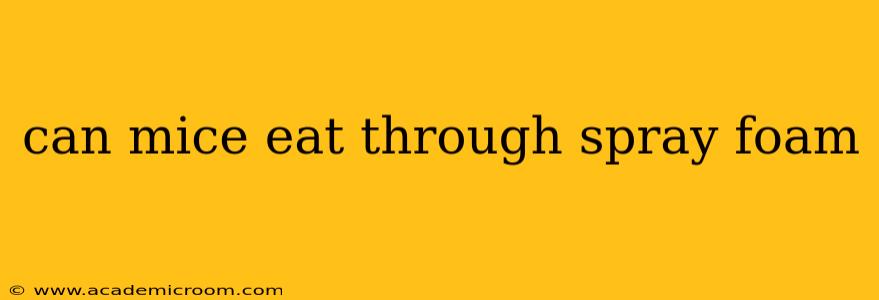Mice are notorious for their ability to squeeze into incredibly tight spaces, but can they actually eat through spray foam insulation? The short answer is: not easily, and likely not completely. While they won't gnaw through it like a piece of wood, their persistent chewing can cause damage and create entry points. This article delves into the specifics, addressing common questions surrounding mice and spray foam insulation.
What is Spray Foam Insulation?
Before we dive into the mouse-eating question, let's briefly discuss spray foam insulation. This popular insulation material is a mixture of polymers and blowing agents that expands significantly upon application, filling cracks and crevices to create a seamless air barrier. Two main types exist: open-cell and closed-cell. Open-cell foam is more affordable and offers better soundproofing, while closed-cell is denser, providing superior insulation and moisture resistance. The chemical composition of both types will impact how susceptible they are to mouse damage.
Can Mice Chew Through Spray Foam Insulation?
While mice possess strong incisors designed for gnawing, spray foam insulation presents a significant challenge. The dense, hardened nature of the foam makes it difficult for them to chew through completely. They might nibble at it, creating small holes or indentations, but it's unlikely they'll create large enough openings to gain access to a building's interior solely by chewing through the foam.
Will Mice Try to Nest in Spray Foam?
Mice are driven by their need for shelter and warmth. While they won't readily eat the foam itself, they may attempt to nest within the existing structure where spray foam has been applied. Any small existing gaps or weaknesses in the foam can be exploited to create nesting areas.
What Damage Can Mice Do to Spray Foam?
The primary damage mice inflict isn't from chewing through the foam but from exploiting its weaknesses. If there are pre-existing holes or gaps in the foam's application, mice can easily enlarge these openings, compromising the insulation's effectiveness and creating entry points. Their chewing around the edges of these openings can also weaken the integrity of the foam over time.
How to Prevent Mice from Damaging Spray Foam Insulation?
The best approach is to prevent mice from accessing areas where spray foam is used. This involves:
- Thorough sealing: Ensure a professional and skilled application of spray foam, leaving no gaps or cracks.
- Regular inspections: Periodically inspect areas where spray foam is applied for any signs of gnawing or damage.
- Rodent control: Employ preventative measures such as sealing entry points, using traps, and considering repellents. A proactive approach to rodent control is far more effective than damage control.
- Proper storage: Store food and garbage securely to prevent attracting rodents.
What Kind of Damage is Most Likely?
Instead of completely chewing through spray foam, mice are more likely to gnaw at the edges of existing cracks or holes, gradually enlarging them to gain access. They're less likely to eat through solid sections of foam, making preventative sealing critical.
Can spray foam deter mice?
Spray foam itself doesn't act as a rodent repellent. Its effectiveness in preventing mouse damage lies in its ability to create a continuous, solid barrier. Any gaps or weaknesses will be exploited, highlighting the importance of professional application and regular inspection.
Conclusion
While mice can't easily eat through spray foam insulation, their chewing can compromise its effectiveness and create entry points into buildings. The best strategy is a proactive approach: ensure professional installation, regularly inspect for damage, and implement effective rodent control measures. Preventing access is far more effective than trying to repair damage caused by persistent rodents.
